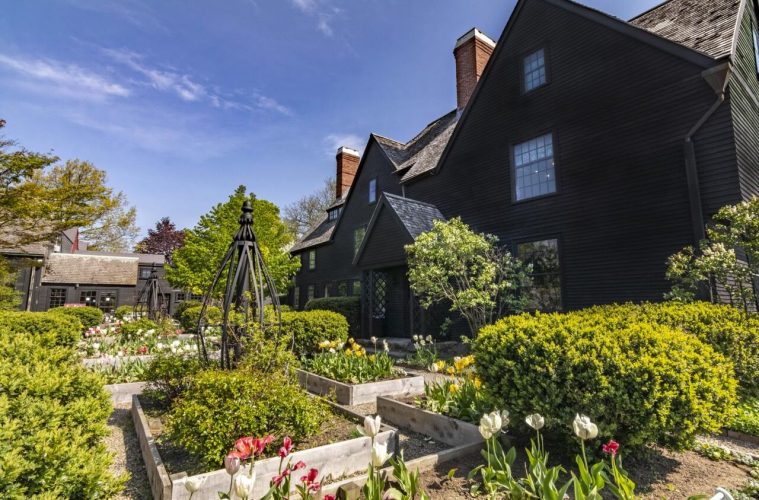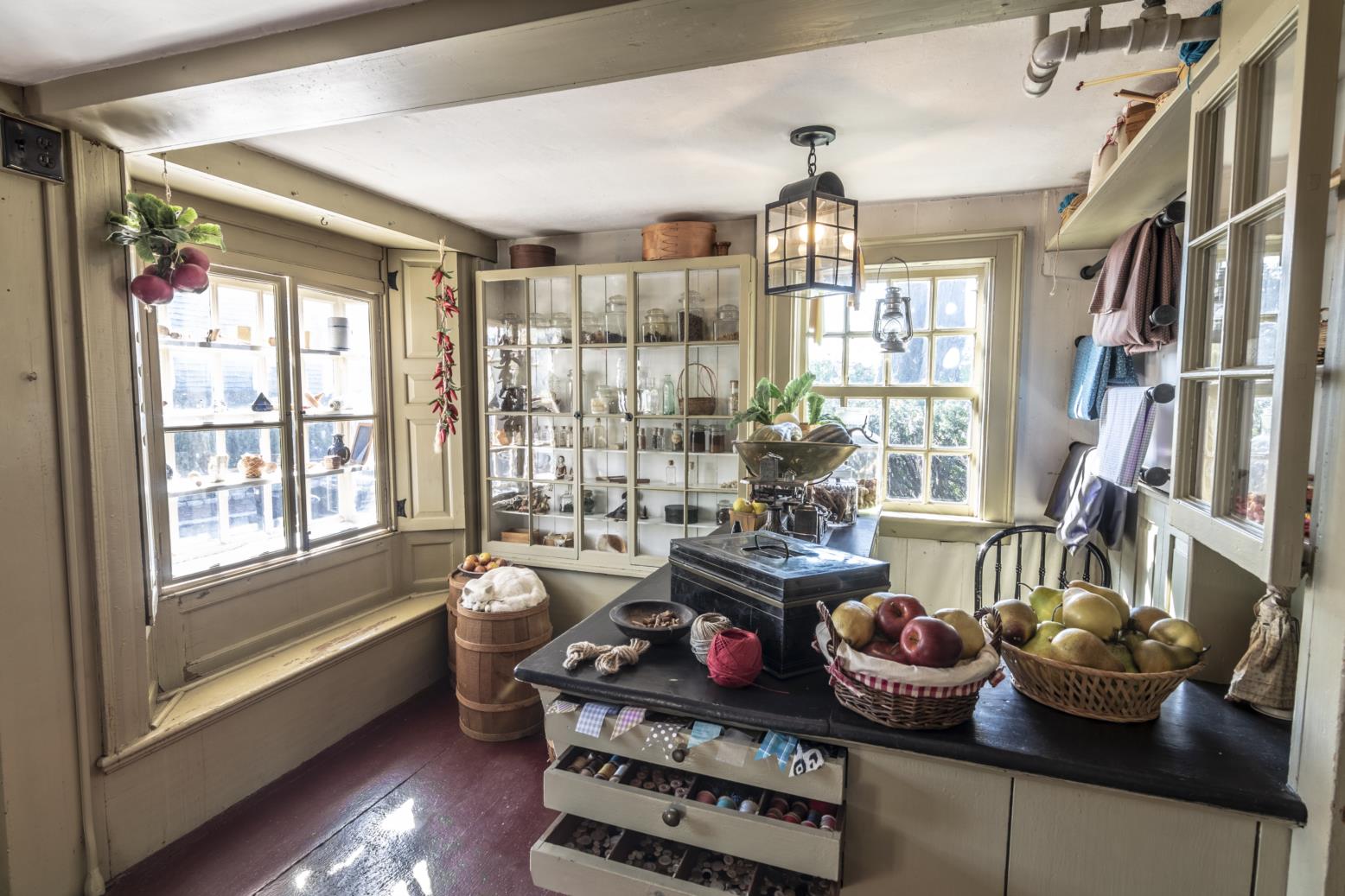
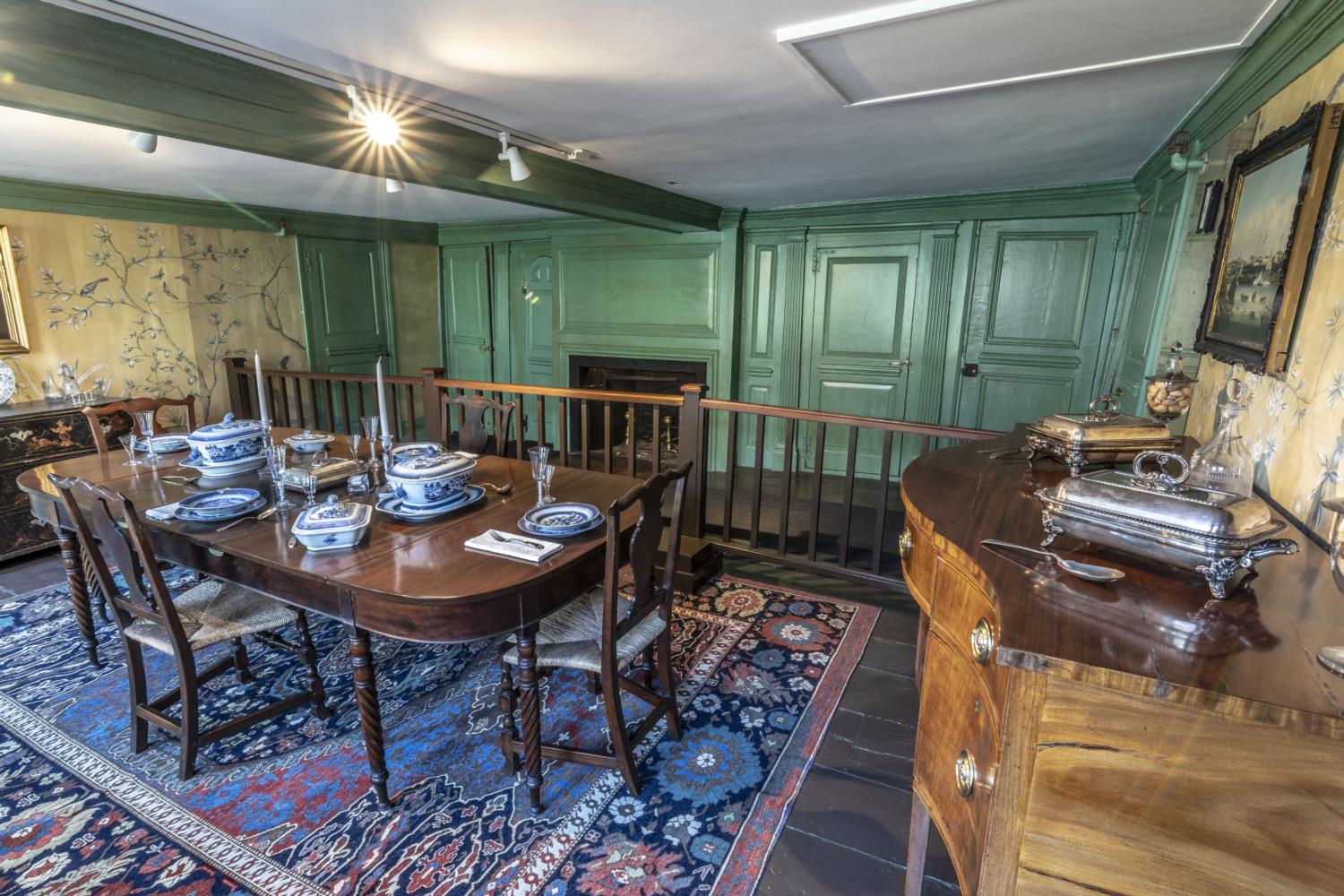 Photos by Katie Noble
Built in 1668 by Captain John Turner, a wealthy merchant, The Gables was home to three generations of his family over 114 years. Afterward, two other families, the Ingersolls and the Uptons, put their thumbprints on the house in response to necessity or taste.
As a young man, Nathanial Hawthorne visited the house often. It was then occupied by his second cousin Susanna Ingersoll, who inherited the house from her father, Captain Samuel Ingersoll. She would become the longest resident of the house, remaining there unmarried and childless for 47 years after the death of her father (although she did adopt a son). During long talks, Susanna fueled her cousin’s imagination by sharing the house’s history and lore. At this time in the 1840s, only four gables remained on the house. In one letter, according to senior guide and researcher David Moffat, Hawthorne recalls “going up to the attic to see gables,” which were still there for viewing. The fact that at one time there were seven fascinated him.
Photos by Katie Noble
Built in 1668 by Captain John Turner, a wealthy merchant, The Gables was home to three generations of his family over 114 years. Afterward, two other families, the Ingersolls and the Uptons, put their thumbprints on the house in response to necessity or taste.
As a young man, Nathanial Hawthorne visited the house often. It was then occupied by his second cousin Susanna Ingersoll, who inherited the house from her father, Captain Samuel Ingersoll. She would become the longest resident of the house, remaining there unmarried and childless for 47 years after the death of her father (although she did adopt a son). During long talks, Susanna fueled her cousin’s imagination by sharing the house’s history and lore. At this time in the 1840s, only four gables remained on the house. In one letter, according to senior guide and researcher David Moffat, Hawthorne recalls “going up to the attic to see gables,” which were still there for viewing. The fact that at one time there were seven fascinated him.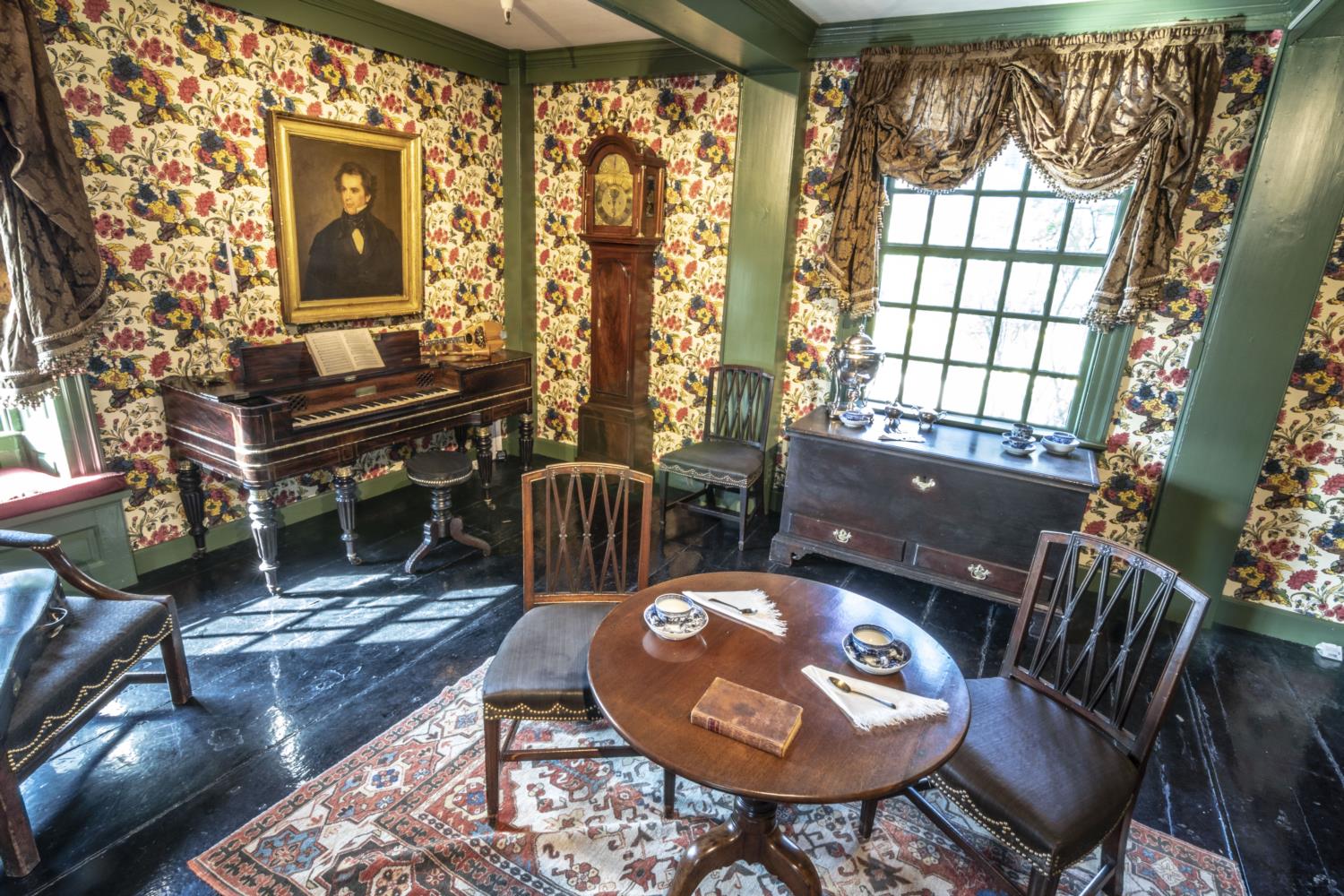 Photo by Katie Noble
Hawthorne’s imagination simmered for nearly a decade before he sat down to write his fourth novel, where in a preface he expressed his intention: “namely, that the wrong-doing of one generation lives into the successive ones….”
After Susanna died, the Turner-Ingersoll Mansion, as it is also known, remained vacant until her adopted son, Horace Connolly, gained possession, but his financial misfortunes forced him to sell it at auction to pay off his debts.
Urged by the looming possibility that it might be torn down and its storied past lost forever, Henry and Elizabeth Upton acquired the house in 1883 after a four-year vacancy. Hawthorne’s legacy was blooming, and the Uptons saw another method of preservation: Offer their home as a museum by charging a small fee. As interest grew, they capitalized on Salem’s ignoble past—the witch hysteria of 1692. They flipped the perception of witches from fearsome spirits to kitschy creatures who flew on broomsticks and may or may not be friendly. Other icons of witches were inscribed on porcelain and glass cups as takeaway souvenirs.
Photo by Katie Noble
Hawthorne’s imagination simmered for nearly a decade before he sat down to write his fourth novel, where in a preface he expressed his intention: “namely, that the wrong-doing of one generation lives into the successive ones….”
After Susanna died, the Turner-Ingersoll Mansion, as it is also known, remained vacant until her adopted son, Horace Connolly, gained possession, but his financial misfortunes forced him to sell it at auction to pay off his debts.
Urged by the looming possibility that it might be torn down and its storied past lost forever, Henry and Elizabeth Upton acquired the house in 1883 after a four-year vacancy. Hawthorne’s legacy was blooming, and the Uptons saw another method of preservation: Offer their home as a museum by charging a small fee. As interest grew, they capitalized on Salem’s ignoble past—the witch hysteria of 1692. They flipped the perception of witches from fearsome spirits to kitschy creatures who flew on broomsticks and may or may not be friendly. Other icons of witches were inscribed on porcelain and glass cups as takeaway souvenirs.
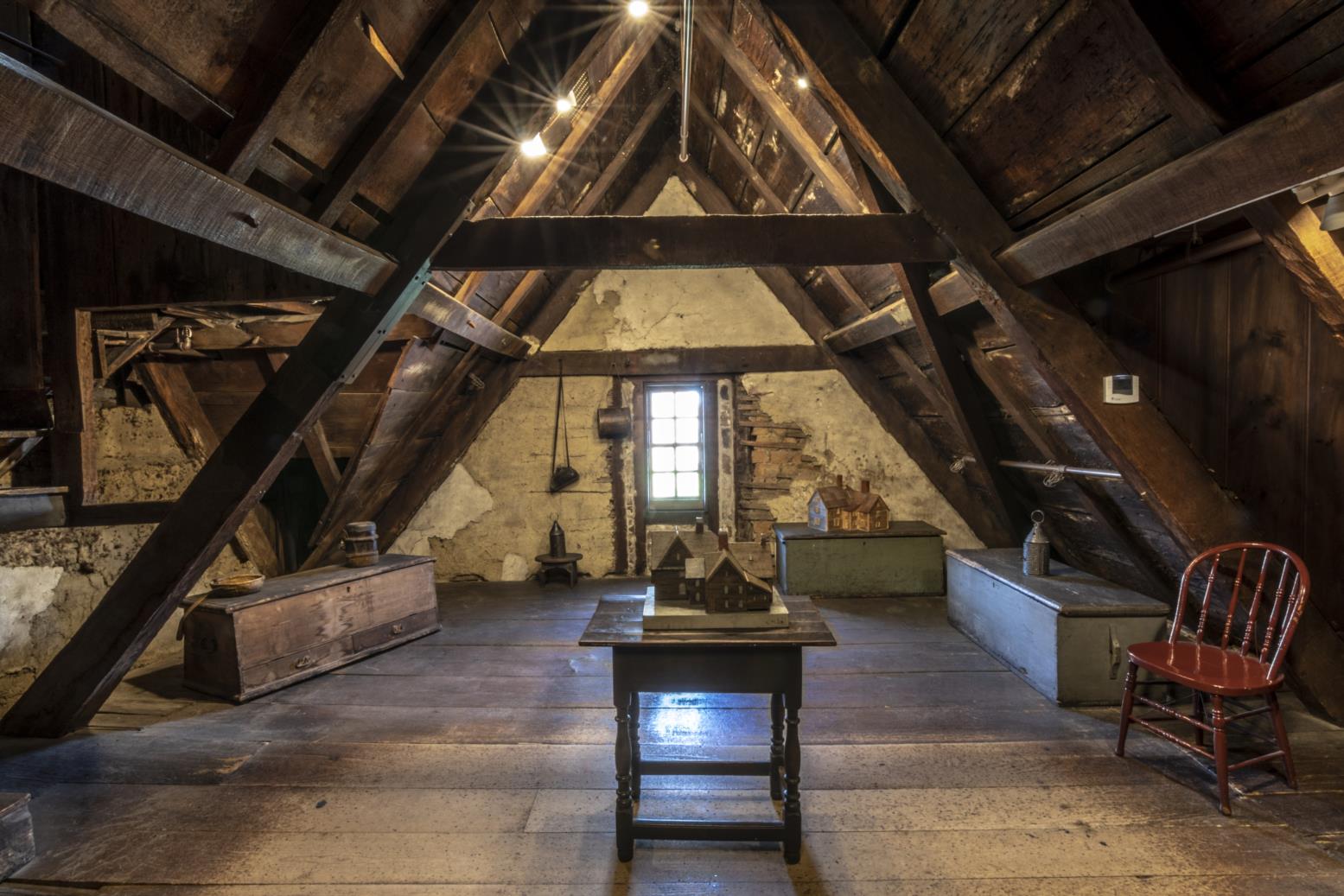 Photo by Katie Noble
It was the final owner, Caroline Emmerton, who bought the “gaunt old house” in 1908 with a vision of repurposing its usefulness in the community. A social activist, she believed The Gables would make a suitable headquarters for a settlement house, with a built-in means of funding its own work while preserving its architectural integrity and literary associations. She declared: “If, as is generally conceded, the settlements do the best Americanization work, should not this settlement excel whose home is the ancient House of Seven Gables, the foundations of which were laid by the first immigrants who came here long ago, strangers in a strange land?”
Emmerton chose Joseph Chandler, a renowned revival architect, to remove earlier modifications and restore the building to the way it looked in 1720. Chandler’s plan was to gut the exterior down to its beams, and then rebuild to its original proportions. He restructured some interiors, but maintained the integrity of the original spaces.
Today, a visitor is guided from the cramped, dark wood-paneled kitchen through a narrow passage to the dining room. This stately room evokes memories of the halcyon years of Salem’s Far East trade, which inspired a design and furnishing revolution in America. Here one can imagine Hawthorne conjuring his intriguing plot during his talks with Susanna. The spot is the “Parlor,” or “Hepzibah’s room,” in the story.
Photo by Katie Noble
It was the final owner, Caroline Emmerton, who bought the “gaunt old house” in 1908 with a vision of repurposing its usefulness in the community. A social activist, she believed The Gables would make a suitable headquarters for a settlement house, with a built-in means of funding its own work while preserving its architectural integrity and literary associations. She declared: “If, as is generally conceded, the settlements do the best Americanization work, should not this settlement excel whose home is the ancient House of Seven Gables, the foundations of which were laid by the first immigrants who came here long ago, strangers in a strange land?”
Emmerton chose Joseph Chandler, a renowned revival architect, to remove earlier modifications and restore the building to the way it looked in 1720. Chandler’s plan was to gut the exterior down to its beams, and then rebuild to its original proportions. He restructured some interiors, but maintained the integrity of the original spaces.
Today, a visitor is guided from the cramped, dark wood-paneled kitchen through a narrow passage to the dining room. This stately room evokes memories of the halcyon years of Salem’s Far East trade, which inspired a design and furnishing revolution in America. Here one can imagine Hawthorne conjuring his intriguing plot during his talks with Susanna. The spot is the “Parlor,” or “Hepzibah’s room,” in the story.
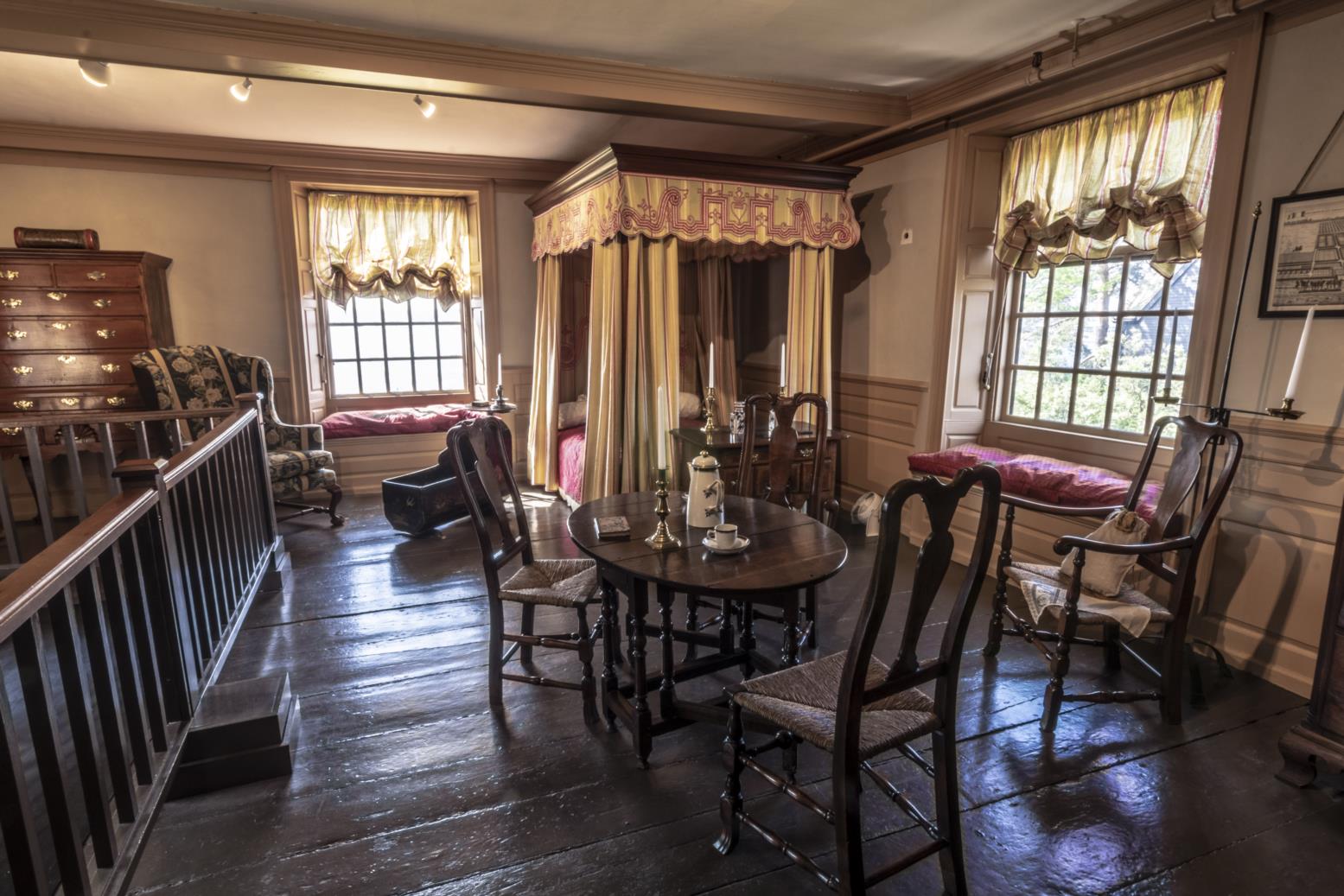 Photo by Katie Noble
Not all is what it seems in this room, however, for a “secret staircase” behind a wood closet leads up 20 winding steps to “Clifford’s room.” The staircase is The Gables’ most intriguing design anomaly, not just for its baffling presence, but for the various speculations it has provoked over the years. For about 90 years, Moffat says, “People were told that the staircase was real from the original house.” But the discovery of blueprints changed that. Chandler’s renovations indicated that it was added around 1910, perhaps to promote the myth of the story and add a dose of mystery to house tours. “It was Emmerton’s vision that created the site,” Moffat claims. “Had it not been for her, I don’t know if the house would have ever survived.”
The rest is history. The tours and events were successful, and their admissions helped fund the settlement process of mostly Polish and Russian immigrants in the neighborhood. Today, The House of the Seven Gables Settlement Association operates social programs for mainstream immigrants to America. Settlement program manager Elsabel Ricon says, “It serves largely Dominican, Caribbean, and Latino communities through ESL courses, citizen preparation, community conversations on immigration, and a summer enrichment program for English language learners.”
On weekends from mid-October to Halloween, two original theatrical events are performed at The Gables. In the first, the novel comes to life in each room as actors assume identities of Hawthorne’s characters. “It seems like the book is acted out in the house,” says Gables executive director Kara McLaughlin. “It’s a different way of experiencing the houses than going on the guided tour.”
7gables.org
Photo by Katie Noble
Not all is what it seems in this room, however, for a “secret staircase” behind a wood closet leads up 20 winding steps to “Clifford’s room.” The staircase is The Gables’ most intriguing design anomaly, not just for its baffling presence, but for the various speculations it has provoked over the years. For about 90 years, Moffat says, “People were told that the staircase was real from the original house.” But the discovery of blueprints changed that. Chandler’s renovations indicated that it was added around 1910, perhaps to promote the myth of the story and add a dose of mystery to house tours. “It was Emmerton’s vision that created the site,” Moffat claims. “Had it not been for her, I don’t know if the house would have ever survived.”
The rest is history. The tours and events were successful, and their admissions helped fund the settlement process of mostly Polish and Russian immigrants in the neighborhood. Today, The House of the Seven Gables Settlement Association operates social programs for mainstream immigrants to America. Settlement program manager Elsabel Ricon says, “It serves largely Dominican, Caribbean, and Latino communities through ESL courses, citizen preparation, community conversations on immigration, and a summer enrichment program for English language learners.”
On weekends from mid-October to Halloween, two original theatrical events are performed at The Gables. In the first, the novel comes to life in each room as actors assume identities of Hawthorne’s characters. “It seems like the book is acted out in the house,” says Gables executive director Kara McLaughlin. “It’s a different way of experiencing the houses than going on the guided tour.”
7gables.org

